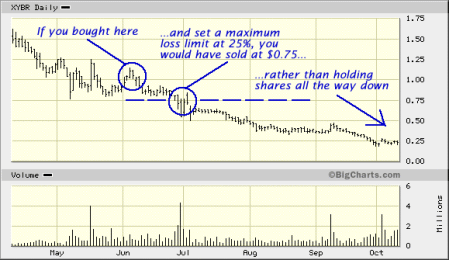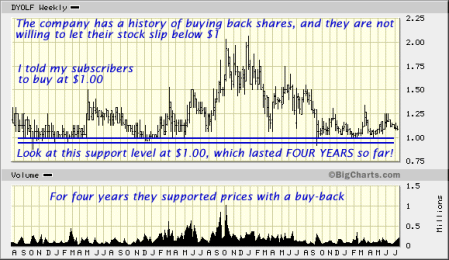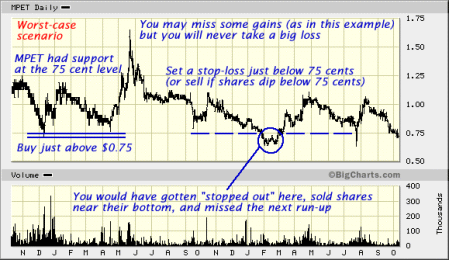


Get Instant Penny Stock Picks from the Authority!Visit www.PeterLeeds.com Right Now!
It is said that the pen is more effectively used for crossing out than for writing down. Similarly, success in stock market investing is often generated by effectively minimizing losses rather than by riding the gains.
All investors will encounter losing stocks. However, the amount to which these damage a portfolio depends on how the investor handles them. The proper placement of stop loss orders and effective diversification can significantly bolster one’s portfolio against the downward pressures that often affect individual stocks.
Preservation of capital is the key. If the most you could lose on a single trade was 2% of your overall portfolio, it would take many, many bad trades before you lost your shirt. That's even if you made no beneficial trades in that time frame.
As theoretical as this sounds, it is relatively simple to implement such a strategy in penny stocks, such that you limit your losses to minimal levels. However, there are surprisingly few investors who do take on such a strategy.

Attitudes that falling penny stocks "can’t go any lower" or "will have to turn around eventually" are killers.
As well, thinking "I won’t sell until I’m at a profit" could tie up your money when it could be making profits elsewhere. Why hold on to a falling penny stock, when you could have cut your losses earlier, then bought it at a bargain once the slide had ended?
On the stock market it is impossible to always avoid stocks that go down after you have bought them. It is not impossible, however, to limit the losses from these to insignificant levels.
The two underlying principles to implement this strategy are price barriers and stop loss orders. If you are a new investor and these terms seem daunting, rest assured that the concepts behind them are very simple.
Note! For many penny stocks, especially OTC-BB issues, your broker will not allow for stop-loss orders. This is yet another reason to stick to penny stocks that trade on the NASDAQ and AMEX, since you will be able to use stop-loss orders.
Note Number Two! I generally do not suggest the use of stop-loss orders, unless you are an experienced trader and the underlying penny stock has high trading volume and low volatility.
A price barrier is simply a level which a share’s price should have a hard time falling through, such as a support level, or lower trend line.
For example, ABC shares may sink to the $1.00 level many times, but may always bounce back up, without ever breaking through to levels of less than a dollar. This could mean that there may be a support level at $1.00.

The reason support levels exist is because there are stronger buying pressures at those prices than selling pressures, which keeps the share price at or above the support.
The opposite holds true for resistance levels, where the price of a penny stock may have trouble breaking above a certain point, despite repeated attempts.
The second concept is that of stop loss orders. This is simply an order to sell your shares if the trading price falls below your stop price. If the shares increase in value you will continue to hold them, but if they fall to or below the level where you set your stop, your sell order kicks in and your shares get bought from you at that price.
Stops can be used to limit losses or to protect profits. Effective use of stop loss orders has seen some penny stock portfolios post a trading profit, despite winning on only 30% of trades. This is because the losses from the 70% of losing trades were very limited, while the gains were allowed to ride, and out paced the minimal losses.

Stop loss orders can help investors protect their capital in the event of a share decline. Price barriers can help investors identify levels where a share’s price may bottom out, or at least will only fall through in the presence of heavy selling pressure.
While both ‘unrelated’ concepts can act as useful investment tools in penny stocks, it is the value-added combination of the two which generates the tremendous effectiveness of the overall methodology.
Three Steps to Limiting Losses (opinion, not advice)
If the support level holds and the penny stock's price remains above $1.00, you have successfully bought in very near the short term bottom in price. You will be in a profit position as the share's price travels higher, with the added insurance of the support level just below your position.
As the penny stocks price does rise, you should adjust your stop loss order upwards. For example, if the price passes $1.20 you may want to move your stop up to $1.09, and if the shares rise above $1.40 you may want to increase you stop to $1.29. This concept will help you lock in your profits. You will be able to take advantage of the price climb, and your shares will only get sold the first time ABC’s stock price reverses and starts heading south once again.

Volatility is a consideration for setting your stop loss price. You do not want to get ‘stopped out’ which simply means that the price sinks to where your stop order has been set, selling your shares, then immediately rises afterwards, further into profitable territory.
By placing your original stop below the support level you have minimized the chance of getting stopped out at first. However the correct placement of stops gets more complicated once you are following a rising price. Individual investors need to decide on their own stop levels based on the volatility of the underlying penny stocks, the momentum of the share’s price trend, and their personal investment style.
The investment methodologies presented here are best suited for investment levels of around $1500 or more per penny stock, so that commission costs will be minimal as a percentage of overall investment value.